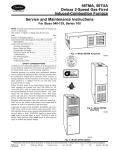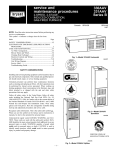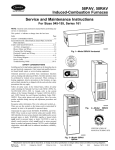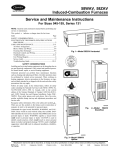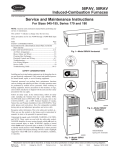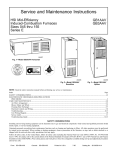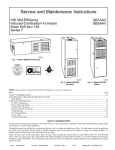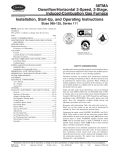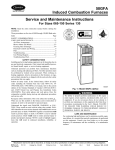Download Carrier 58SMA Instruction manual
Transcript
58SMA, 58SUA Category I and III Gas-Fired Induced-Combustion Furnace Service and Maintenance Instructions For Sizes 060-120, Series 100 NOTE: Read the entire instruction manual before starting the installation. SAFETY CONSIDERATIONS Installing and servicing heating equipment can be hazardous due to gas and electrical components. Only trained and qualified personnel should install, repair, or service heating equipment. Untrained personnel can perform basic maintenance functions such as cleaning and replacing air filters. All other operations must be performed by trained service personnel. When working on heating equipment, observe precautions in the literature, on tags, and on labels attached to or shipped with the unit and other safety precautions that may apply. A94087 Fig. 1—Model 58SMA Horizontal Follow all safety codes. In the United States, follow all safety codes including the National Fuel Gas Code NFPA No. 541992/ANSI Z223.1-1992. In Canada, refer to the current edition of the National Standard of Canada CAN/CGA-B149.1- and .2-M91 Natural Gas and Propane Gas Installation Codes. Wear safety glasses and work gloves. Have fire extinguisher available during start-up and adjustment procedures and service calls. ® Recognize safety information. This is the safety-alert symbol . When you see this symbol on the furnace and in instructions or manuals, be alert to the potential for personal injury. Understand the signal words DANGER, WARNING, and CAUTION. These words are used with the safety-alert symbol. DANGER identifies the most serious hazards which will result in severe personal injury or death. WARNING signifies a hazard that could result in personal injury or death. CAUTION is used to identify unsafe practices which would result in minor personal injury or product and property damage. The ability to properly perform maintenance on this equipment requires certain expertise, mechanical skills, tools, and equipment. If you do not possess these, do not attempt to perform any maintenance on this equipment other than those procedures recommended in the User’s Manual. A FAILURE TO FOLLOW THIS WARNING COULD RESULT IN POSSIBLE DAMAGE TO THIS EQUIPMENT, SERIOUS PERSONAL INJURY, OR DEATH. ama CANADIAN GAS ASSOCIATION R A PP R O VED A94086 Fig. 2—Model 58SMA Downflow CARE AND MAINTENANCE For continuing high performance and to minimize possible equipment failure, it is essential that periodic maintenance be performed on this equipment. Consult your local dealer as to the proper frequency of maintenance and the availability of a maintenance contract. A94085 Fig. 3—Model 58SUA Upflow Manufacturer reserves the right to discontinue, or change at any time, specifications or designs without notice and without incurring obligations. Book 1 4 PC 101 Catalog No. 565-888 Printed in U.S.A. Form 58S-1SM Pg 1 4-94 Replaces: New Tab 6a 8a Never store anything on, near, or in contact with the furnace, such as: 1. Spray or aerosol cans, rags, brooms, dust mops, vacuum cleaners, or other cleaning tools. 2. Soap powders, bleaches, waxes or other cleaning compounds, plastic or plastic containers, gasoline, kerosene, cigarette lighter fluid, dry cleaning fluids, or other volatile fluids. 3. Paint thinners and other painting compounds, paper bags, or other paper products. A failure to follow this warning could result in corrosion of the heat exchanger, fire, personal injury, or death. Never operate unit without a filter or with filter access door removed. A failure to follow this warning could result in fire, personal injury, or death. 1. Horizontal and Downflow Each furnace requires 2 filters which are installed in the return-air duct. (See Fig. 4 and 5.) To remove filters for cleaning or replacement, proceed as follows: a. Disconnect electrical power before removing access door. b. Remove blower access door. c. Reach up behind top plate, tilt filters toward center of return-air plenum and remove filters. Clean washable filters as needed or replace non-washable or torn filters. Turn the gas and electrical supplies to the unit to OFF before performing any maintenance or service. Follow the operating instructions on the label attached to the furnace. A failure to follow this warning could result in personal injury. ;;; ;;; AIRFLOW 12″ 4″ D FIELD-SUPPLIED FILTER RETAINERS As with any mechanical equipment, personal injury can result from sharp metal edges, etc.; therefore, be careful when removing parts. A82173 Fig. 4—Horizontal Filter Arrangement ;;;; ;;;; ;;;; ;;;; ;;;; ;;;; ;;;; ;;;; ;;;; AIRFLOW AIR FILTER ARRANGEMENT — The field-supplied air filter arrangement may vary depending on the application. Refer to Table 1 or 2 for filter size information. INSTALLATION POSITION OF FILTERS Table 1—Recommended Filter Size Information (Downflow/Horizontal—In.) FURNACE CASING WIDTH 14-3/16 17-1/2 21 ;; ; ; ;;;;; ;;;;;;;; ;;; ;; The minimum maintenance that should be performed on this equipment is as follows: 1. Check and clean air filter each month or more frequently if required. Replace if torn. 2. Check blower motor and wheel for cleanliness each heating and cooling season. Clean and lubricate as necessary. 3. Check electrical connections for tightness and controls for proper operation each heating season. Service as necessary. RETURN-AIR PLENUM FILTER SIZE (2) 14 X 20 X 1 (2) 14 X 20 X 1 (2) 16 X 20 X 1 Table 2—Recommended Filter Size Information (Upflow—In.) FURNACE CASING WIDTH 14-3/16 17-1/2 21 24-1/2 FILTER Side Return (1) 16 X 25 X 1 (1) 16 X 25 X 1 (1) 16 X 25 X 1 (2) 16 X 25 X 1 SIZE Bottom Return (1) 14 X 25 X 1 (1) 16 X 25 X 1 (1) 20 X 25 X 1 (1) 24 X 25 X 1 ACCESS DOOR A88486 Fig. 5—Position of Filters 2 MOUNTING SCREWS DRAFT SAFEGUARD SWITCH RELIEF BOX PRESSURE SWITCHES MAIN LIMIT SWITCH VENT PIPE ENCLOSURE AUXILIARY LIMIT SWITCH CONTROL MOUNTING SCREWS DRAFT SAFEGUARD SWITCH MANUAL RESET LIMIT SWITCH PRESSURE SWITCHES CONTROL RELIEF BOX MANUAL RESET LIMIT SWITCHES A94136 A93394 Fig. 6—Model 58SUA Upflow Fig. 7—Model 58SMA Downflow Some motors have prelubricated sealed bearings and require no lubrication. These motors can be identified by the absence of oil ports on each end of the motor. For those motors with oil ports, lubricate motor every 5 years if motor is used on intermittent operation (thermostat FAN switch in AUTO position), or every 2 years if motor is in continuous operation (thermostat FAN switch in ON position). Clean and lubricate as follows: 1. Disconnect electrical power before removing access doors. 2. Remove blower access door. 3. Disconnect vent pipe on downflow/horizontal furnace only. a. Remove vent pipe enclosure. b. Disconnect vent pipe and remove short piece of pipe from furnace. c. Disconnect wires from auxiliary limit on blower housing (if present). 4. Remove control. 5. Remove electrical leads from control. (See Fig. 6 and 7.) Note location of wires for reassembly. 6. Remove screws holding blower assembly to blower deck and slide blower assembly out of furnace. 7. Loosen a screw in strap holding motor capacitor to blower housing and slide capacitor out from under strap. d. Clean washable filters by spraying tap water through filter from opposite direction of airflow. Rinse and let dry. Oiling or coating of filters is not recommended or required. e. Reinstall filters. f. Replace access door and restore electrical power to furnace. 2. Upflow Each furnace requires 1 or 2 filters which are installed in the blower compartment. (See Fig. 6.) To remove filters for cleaning or replacement, proceed as follows: a. Disconnect electrical power before removing access doors. b. Remove filters from field-provided retainers and clean washable filters as needed. Replace non-washable or torn filters. c. Clean washable filters by spraying tap water through filter from opposite direction of airflow. Rinse and let dry. Oiling or coating of filter is not recommended or required. d. Reinstall filters in retainers. e. Replace access doors and restore electrical power to furnace. BLOWER MOTOR AND WHEEL — For long life, economy, and high efficiency, clean accumulated dirt and grease from the blower wheel and motor annually. The following steps should be performed by a qualified service technician: 3 fittings during disconnection. Replace any damaged plastic vent pipe using information in the accessory Category III conversion instruction, or contact your distributor. 8. Mark blower wheel, motor, and motor support in relation to blower housing before disassembly to ensure proper reassembly. 4. Remove 2 screws that secure relief box. (See Fig. 6 or 7.) 9. Loosen setscrew holding blower wheel on motor shaft. 5. Disconnect wires to the following components. Mark wires to aid in reconnection: 10. Remove bolts holding motor and motor mount to blower housing and slide motor and mount out of housing. Disconnect ground wire attached to blower housing before removing motor. a. Draft safeguard switch (Category I vents only). b. Inducer motor. 11. Lubricate motor (when oil ports are provided). c. Pressure switch(es). a. Remove dust caps or plugs from oil ports located at each end of motor. d. Limit overtemperature switch(es). e. Gas valve. b. Use a good grade of SAE 20 nondetergent motor oil and put 1 teaspoon, 5 cc, 3/16 oz, or 16 to 25 drops in each oil port. Do not over-oil. f. Hot surface ignitor. g. Flame-sensing electrode. c. Allow time for total quantity of oil to be absorbed by each bearing. h. Wiring connectors leading to control. 6. Remove 8 screws that secure flue collector box to center panel. Be careful not to damage sealant. d. After oiling motor, be sure to wipe excess oil from motor housing. 7. Remove complete inducer assembly from furnace, exposing flue openings. e. Replace dust cap or plugs on oil ports. 12. Remove blower wheel from housing. 8. Using field-provided small wire brush, steel spring cable, reversible electric drill, and vacuum cleaner, clean cells as follows: a. Mark cutoff location to ensure proper reassembly. b. Remove screws holding cutoff plate and remove cutoff plate from housing. a. Assemble wire brush and steel spring cable. (1.) Use 48 in. of 1/4-in. diameter high-grade steel spring cable (commonly known as drain clean-out or RotoRooter cable). c. Lift blower wheel from housing through opening. 13. Clean blower wheel and motor using a vacuum with soft brush attachment. Do not remove or disturb balance weights (clips) on blower wheel blades. The blower wheel should not be dropped or bent as balance will be affected. (2.) Use 1/4-in. diameter wire brush (commonly known as 25-caliber rifle cleaning brush). 14. Reinstall blower wheel by reversing items 12 a. through c. Be sure wheel is positioned for proper rotation. NOTE: The materials needed in items (1.) and (2.) can usually be purchased at local hardware stores. 15. Reassemble motor and blower by reversing items 6 through 10. If motor has ground wire, be sure it is connected as before. (3.) Insert twisted wire end of brush into end of spring cable, and crimp tight with crimping tool or strike with ball-peen hammer. TIGHTNESS IS VERY IMPORTANT. Be sure the motor is properly positioned in the blower housing. The motor oil ports (when used) must be at a minimum of 45° above the horizontal centerline of the motor after the blower assembly has been reinstalled in the furnace. (4.) Remove metal screw fitting from wire brush to allow insertion into cable. b. Clean each heat exchanger cell. (1.) Attach variable-speed, reversible drill to end of spring cable (end opposite brush). 16. Reinstall blower assembly in furnace. Connect electrical leads to control. Please note that connections are polarized for assembly. DO NOT FORCE. (2.) Remove cell outlet plates. IMPORTANT: Replace screws in center panel before cleaning. (3.) Insert brush end of cable into upper opening of cell and slowly rotate with drill. DO NOT force cable. Gradually insert at least 36 in. of cable into 2 upper passes of cell. (See Fig. 8.) 17. Reinstall control. (See item 13 in following section for reassembly of vent pipe and flue enclosure for downflow/horizontal furnaces.) CLEANING HEAT EXCHANGER The following steps should be performed by a qualified service technician: NOTE: Deposits of soot and carbon indicate the existence of a problem which needs to be corrected. Take action to correct the problem. If it becomes necessary to clean the heat exchanger because of carbon deposits, soot, etc., proceed as follows: 1. Turn gas and power to furnace off. 2. Remove control and blower access doors. 3. Remove vent pipe enclosure on downflow/horizontal furnace only and disconnect vent pipe from relief box. NOTE: If high temperature plastic, Category III Special Gas Vent, is used, use special care not to crack or damage the pipe and A91252 Fig. 8—Cleaning Heat Exchanger Cell 4 (4.) Work cable in and out of cell 3 or 4 times to obtain sufficient cleaning. DO NOT pull cable with great force. Reverse drill and gradually work cable out. d. Limit overtemperature switch(es). e. Gas valve. f. Hot surface ignitor. (5.) Remove burner assembly and cell inlet plates. g. Flame-sensing electrode. NOTE: Be very careful when removing the burner assembly to avoid breaking the ignitor. See Fig. 9 for the correct ignitor location. h. Wiring connectors leading to control. 13. Reconnect vent pipe to relief box. When applicable replace vent pipe enclosure. 11 32" 13 32" BURNER If a Category III, vertical or horizontal, high temperature plastic Special Gas Vent is used, the vent pipe manufacturer’s recommended high temperature adhesive/sealant MUST be used at the joint between the relief box flue collar and the heat dissipater and at all joints loosened during servicing. If the accessory Category III vent instructions are not available, contact your distributor for correct sealant. DO NOT drill or use screws, rivets, or any other mechanical fasteners on plastic vent pipe. A failure to follow this warning may result in spillage of flue gas products causing property damage, personal injury, or death. CELL PANEL HOT SURFACE IGNITER ASSEMBLY 14. Replace blower door only. 15. Turn power and gas to furnace on. 16. Set thermostat and check furnace for proper operation. C L 7 8" C L 17. Verify blower airflow and speed changes between heating and cooling. IGNITER 18. Check for gas leaks. BURNER 19. If Category III high temperature plastic Special Gas Vent pipe is used, inspect entire vent system for any signs of damage or deterioration, such as cracks, unevenness, or discoloration. Inspect and check all sealed joints during furnace operation for an airtight seal and reseal any joints that are not clearly well-sealed. Use only the high temperature adhesive/sealant recommended by the vent pipe manufacturer. If you are unsure of correct sealant, contact your distributor. IGNITER ASSEMBLY A93347 Fig. 9—Position of Ignitor to Burner 20. Replace control door. (6.) IMPORTANT: Replace screws in center panel and cells before cleaning. (7.) Insert brush end of cable in lower opening of cell, and proceed to clean 2 lower passes of cell in same manner as 2 upper passes. Never use a match or other open flame to check for gas leaks. Use a soap-and-water solution. A failure to follow this warning could result in fire, personal injury, or death. (8.) Repeat foregoing procedures until each cell in furnace has been cleaned. (9.) Using vacuum cleaner, remove residue from each cell. ELECTRICAL CONTROLS AND WIRING (10.) Using vacuum cleaner with soft brush attachment, clean burner assembly. NOTE: There may be more than 1 electrical supply to unit. The electrical ground and polarity for 115-v wiring must be maintained properly. Refer to Fig. 10 for field wiring information and to Fig. 11 for unit wiring information. If the polarity is NOT correct, the furnace control will display code 02 on the status LED and prevent heat operation. The control system also requires an earth ground for proper operation of the microprocessor. (11.) Reinstall cell outlet plates and screws FIRST; then, reinstall cell inlet plates and burner assembly. Care must be exercised to center the burners in the cell openings. 9. After cleaning flue openings, check sealant on flue collector to ensure that it has not been damaged. If new sealant is needed, contact your dealer or distributor. With power disconnected to unit, check all electrical connections for tightness. Tighten all screws on electrical connections. If any smoky or burned connections are noticed, disassemble the connection, clean all parts and stripped wire, and reassemble properly and securely. Electrical controls are difficult to check without proper instrumentation; therefore, reconnect electrical power to unit and observe unit through 1 complete operating cycle. 10. Clean and replace flue collector assembly, making sure all 8 screws are secure. 11. Reinstall relief box. 12. Reconnect wires to the following components: a. Draft safeguard switch (Category I vents only). The 24-v circuit contains an automotive-type, 3-amp fuse located on the main control. Any 24-v electrical shorts during installation, service, or maintenance could cause this fuse to blow. If fuse b. Inducer motor. c. Pressure switches. 5 FIELD 24-VOLT WIRING FIELD 115-, 208/230-, 460-VOLT WIRING FACTORY 24-VOLT WIRING FACTORY 115-VOLT WIRING W FOUR WIRE Y R G 1-STAGE THERMOSTAT TERMINALS FIELD-SUPPLIED FUSED DISCONNECT TWO-WIRE HEATINGONLY BLK BLK W2 WHT WHT COM 208/230- OR 460-VOLT THREE PHASE W/W1 GND 115-VOLT FIELD- JUNCTION SUPPLIED BOX FUSED CONTROL DISCONNECT BOX Y/Y2 R GND CONDENSING UNIT G 24-VOLT TERMINAL BLOCK FURNACE 208/230VOLT SINGLE PHASE NOTE: Connect Y-terminal as shown for proper operation. NOTE: If any of the original wire, as supplied, must be replaced, use same type or equivalent wire. A93378 Fig. 10—Heating and Cooling Application Wiring Diagram have expired in order to retrieve any previously stored codes. Remove 1 of the red main limit wires for 1 to 4 sec until the LED light goes out, then reconnect it. (Do not leave red wire disconnected for longer periods of time as the control will assume an overtemperature condition exists and will respond with indoor blower operation.) This places the control in the status recall mode and displays the first code stored in memory. Record the code and repeat the disconnect and reconnect of the red wire, recording each code until code 11 is displayed indicating no additional faults. After the last code is displayed or after 2 minutes in the code recall mode, the control will return to normal standby mode. replacement is required, use ONLY a 3-amp fuse. The control will display code 24 when the fuse needs replacement. The control in this furnace is equipped with an LED status light to aid in installation, servicing, and troubleshooting. It can be viewed through the sightglass or window on the blower compartment door. The control indicates status with the LED on continuously, rapid flashing, or a code composed of 2 digits (the first digit is the number of short flashes, the second is the number of long flashes). Refer to the information label on the blower compartment door for code explanations and useful troubleshooting suggestions. It is important to note that the power to the furnace must not be interrupted and the furnace blower door must not be removed until the LED status code(s) is recorded. When power to the control is interrupted, the status memory is erased. Use any recorded fault codes, the information label, and the troubleshooting diagram on the last page to diagnose and correct any problem condition. The control will store up to 5 previous codes but will not store non-current codes longer than 48 hr. There must not be any thermostat inputs to the control present and all time delays must 6 7 LEGEND LED S TWIN TEST TJ M ORN RED RED YEL P1 PL2 PL6 1 2 HSI L2 L1 SEC2 SEC1 LO-GAS HEAT HI-GAS HEAT HI-COOL FU1 PARK EAC-1 EAC-2 COMMON PR2 PR1 COMPONENT TEST BRN GRY CONNECTION DIAGRAM AUXILIARY LIMIT SWITCH, OVERTEMP.- MANUAL RESET, SPST-(N.C.) AUXILIARY LIMIT SWITCH, OVERTEMP.- AUTO RESET, SPST-(N.C.) BLOWER MOTOR SPEED CHANGE RELAY, SPDT BLOWER MOTOR SPEED CHANGE RELAY, SPDT BLOWER MOTOR, 4-SPEED, PERMANENT-SPLIT-CAPACITOR BLOWER MOTOR RELAY, SPST-(N.O.) CAPACITOR MICROPROCESSOR AND CIRCUITRY DRAFT SAFEGUARD SWITCH ELECTRONIC AIR CLEANER CONNECTION (115 VAC 1 AMP MAX.) ELECTRONIC AIR CLEANER CONNECTION (COMMON) FLAME ROLLOUT SWITCH OVERTEMP.-MANUAL RESET, SPST-(N.C.) FLAME ROLLOUT SWITCH OVERTEMP.-MANUAL RESET, SPST-(N.C.) FLAME-PROVING SENSOR ELECTRODE FUSE, 3 AMP, AUTOMOTIVE BLADE TYPE, FACTORY INSTALLED FUSE, FIELD INSTALLED GAS VALVE-REDUNDANT LOW-HEAT OPERATORS, 2-STAGE HIGH-HEAT PRESSURE SWITCH, SPST-(N.O.) HIGH-HEAT PRESSURE SWITCH RELAY, SPST-(N.C.) HOT-SURFACE IGNITER (115 VAC) HOT-SURFACE IGNITER RELAY, SPST-(N.O.) 24VAC HUMIDIFIER CONNECTION (.5 AMP. MAX.) INDUCED DRAFT MOTOR, 2-SPEED, SHADED-POLE INDUCER MOTOR RELAY, SPST-(N.O.) INDUCER MOTOR SPEED CHANGE RELAY, SPDT BLOWER DOOR INTERLOCK SWITCH, SPST-(N.O.) JUNCTION BOX LIGHT-EMITTING DIODE FOR STATUS CODES LOW GAS-PRESSURE SWITCH, SPST-(N.O.) LOW-HEAT PRESSURE SWITCH, SPST-(N.O.) LIMIT SWITCH, OVERTEMPERATURE-AUTO RESET, SPST-(N.O.) MAIN GAS VALVE RELAY, DPST-(N.O.) -1 = VALVE -2 = HUMIDIFIER G HUM ALS2 LGPS NOTE#8 FSE 2 3 PL3 TRAN TRAN TWIN/TEST PLUG RECEPTACLE FIELD SPLICE EQUIPMENT GROUND FIELD GROUND FIELD WIRING SCREW TERMINAL TWINNING JUMPER, SPDT FOR MASTER OR SLAVE STATUS-(MANUAL CHANGE-OVER) TRANSFORMER-115VAC/24VAC 1-CIRCUIT TWINNING BUSS CONNECTOR, ALSO STATUS CODE RECALL JUNCTION TERMINAL CONTROL TERMINAL FACTORY POWER WIRING (115VAC) FACTORY CONTROL WIRING (24VAC) FIELD POWER WIRING (115VAC) FIELD CONTROL WIRING (24VAC) CONDUCTOR ON CONTROL TJ BLWM BRN 2-CIRCUIT HSI CONNECTOR 2-CIRCUIT LINE/NEUTRAL CONNECTOR WHT BLK YEL BLU RED GRN PL6 PL7 COM HI MED HI MED LO LO BRN WHT BLK CAP GRN GRN 2 PL7 WHT FU2 BLK L2 JB L1 C 12-CIRCUIT CONNECTOR 9-CIRCUIT CONNECTOR 3-CIRCUIT IDM CONNECTOR 1-CIRCUIT FPS CONNECTOR RED BLU BLU RED WHT BLK 1 ILK M GV FUSED DISCONNECT SWITCH (WHEN REQ'D) NOTE #1 HI P BLU GRN BRN PL1 PL2 PL3 PL4 BLK RED 1 WHT GRN WHT IDM HPS NOTE#5 CPU TWINNING JUMPER TJ MGVR-2 24VAC TRAN 115VAC PL2 PL1 HPSR MGVR-1 SEC2 PR2 COMMON 11 8 7 10 1 4 5 6 9 3 12 2 2 6 5 1 8 7 4 9 3 3 1 2 1 2 NOTE#7 N/A C M ALS1 LS NOTE#8 FSE HI HPS P PL4 GV LGPS NOTE#8 N/A LPS DSS (WHEN USED) ALS2 BRN L2 BLWM FRS2 IDM HI COM LO HSI CAP BRN FRS1 (WHEN USED) N/A N/A N/A PL3 PL6 NOTE#4 LO MED LO MED HI HI COM SCHEMATIC DIAGRAM (NATURAL GAS & PROPANE) A94133 1. USE ONLY COPPER WIRE BETWEEN THE DISCONNECT SWITCH AND THE UNIT. 2. IF ANY OF THE ORIGINAL WIRE, AS SUPPLIED, MUST BE REPLACED, USE THE SAME OR EQUIVALENT TYPE WIRE. 3. INDUCER (IDM) AND BLOWER (BLWM) MOTORS CONTAIN INTERNAL AUTO-RESET THERMAL OVERLOAD SWITCHES. 4. BLOWER MOTOR SPEED SELECTIONS ARE FOR AVERAGE CONDITIONS. SEE INSTALLATION INSTRUCTIONS FOR DETAILS ON OPTIMUM SPEED SELECTION. 5. REPLACE ONLY WITH A 3-AMP FUSE. 6. AUXILIARY LIMIT SWITCHES (ALS1 & 2) USED ON DOWNFLOW MODELS ONLY. 7. THIS WIRE MUST BE CONNECTED TO FURNACE SHEET METAL FOR CONTROL TO PROVE FLAME. 8. FACTORY CONNECTED WHEN LGPS NOT USED. 9. SYMBOLS ARE AN ELECTRICAL REPRESENTATION ONLY. 10. BLOWER-ON DELAY: GAS HEATING 45 SECONDS, COOLING/HEAT PUMP 2 SECONDS. 11. GAS HEAT BLOWER-OFF DELAY IS 135 SECONDS. 12. COOLING/HEAT PUMP BLOWER-OFF DELAY IS 90 SECONDS. 13. IGNITION-LOCKOUT WILL OCCUR AFTER FOUR CONSECUTIVE UNSUCCESSFUL TRIALS-FOR-IGNITION. CONTROL WILL AUTOMATICALLY RESET AFTER THREE HOURS. 14. CONTROL MUST BE GROUNDED AT PIN 10 OF 12-PIN CONNECTOR. 15. NA - NOT APPLICABLE. 322016-401 REV. A NOTES: COM Y/Y2 G W2 SLAVE W/W1 MASTER TWIN TEST R PR1 PARK HI-GASHEAT LO-GASHEAT HI-COOL BHI/LOR EAC-2 IHI/LOR EAC-1 BHT/CLR FU1 SEC1 IDR HSIR BLWR HUM L1 PL7 TO 115VAC FIELD DISCONNECT SWITCH EQUIPMENT GROUND NOTE#1 ILK Fig. 11—Unit Wiring Diagram To initiate the component test sequence with no thermostat inputs and with all inducer Post-Purge and Blower-Off Delay periods completed, short the "TWIN/TEST" terminal to the "Com" terminal for about two seconds. The control will turn ON the inducer motor Low-Speed, inducer motor High-Speed, HSI, blower motor Continuous-Fan Speed, blower motor Heat Speed, and blower motor High-Cool Speed for 7-15 seconds each. Neither the gas valve nor the humidifier will be turned ON. ALS1 ALS2 BHI/LOR BHT/CLR BLWM BLWR CAP CPU DSS EAC-1 EAC-2 FRS1 FRS2 FSE FU1 FU2 GV HPS HPSR HSI HSIR HUM IDM IDR IHI/LOR ILK JB LED LGPS LPS LS MGVR ALS1 DSS LPS (WHEN USED) NOTE#6 FURNACE CONTROL W2 Com W/W1 Y/Y2 R 24V FRS1 (WHEN USED) RED RED RED FRS2 ORN ORN ORN YEL YEL RED BLK RED WHT LS GRY 2 1 PL4 WHT WHT BRN BLK 3 1 GRN 7 8 9 BLK BLK WHT WHT NOTE#8 (WHEN USED) BLU 1 2 3 BLK GRY 12 11 10 WHT RED BLK BLU NOTES: 1. Refer to information label on blower compartment door for procedure for use of LED status codes and problem solving suggestions. 2. LED indicator is viewed through window on blower compartment door. 3. If 115-vac power is energized or interrupted during a call for heat, the indoor blower will run for 90 sec before a gas heating cycle begins – Code 12. 4. After replacing any component, verify correct operating sequence. TROUBLESHOOTING GUIDE ! WARNING ELECTRICAL SHOCK HAZARD ONLY QUALIFIED AND TRAINED SERVICE PERSONNEL SHOULD PERFORM THIS PROCEDURE If LED is flashing rapidly, check line voltage polarity. If Code 24 is displayed, check for blown fuse. If LED is OFF, check line voltage and 24-v transformer. START If Code 45 is displayed, replace control. Is indoor blower ON? Yes No Turn thermostat OFF. 24v should be present across C and W. If not, check for: 1. Open thermostat. 2. Open 24-v fuse (FU1) – Code 24. 3. Failed transformer. If Code 23 is displayed, the pressure switch(es) is stuck closed. Replace switch and/or check pressure tube for blockage. Cycle 115-v power OFF for 3 sec, then ON. No No System malfunction – Code 21. Continuous LED? No Yes Set thermostat to call for heat. Set FAN switch to AUTO. Draft inducer motor starts. Yes Is Code 22 displayed? No Yes Yes Main burners ignite. No Replace control only if Code 45 is displayed or if all checks are OK. No Replace control only if Code 45 is displayed or if all checks are OK. LPS, DSS, or ALS open while HPS if closed (High-Gas-Heat only) – Code 43. Is the gas valve control knob in the OPEN or ON position? 24v should be present across the gas valve terminals C and M/P (and C and HI for high-fire test) during the 7-sec ignition trial. If not, check all low-voltage wiring connections to valve. 15-sec inducer pre-purge. Yes If Code 32 is displayed check for: 1. Open gas inlet pressure switch (when used). 2. Open pressure switch (LPS) and/or tube – Code 32. 3. Open draft safeguard switch (DSS) – Code 32. 4. Open auxiliary switch (ALS)(downflow/horizontal only) – Code 32. 5. Check all low-voltage wiring connections. Control will attempt to light burners 4 times (approximately 1 minute between attempts – Code 34). Voltage is present at the gas valve for 7 sec during each ignition trial. System will lockout after 4 attempts. Flame present when not normal. Replace gas valve. Ignitor warms up and glows orange/yellow; 17-sec warm-up. Replace control only if all checks are OK. 115v should be present at the inducer motor. If so, replace inducer motor. If not, check 115-v wiring. 115v should be present at the ignitor. If so, replace the ignitor; if not, check 115-vac wiring to ignitor. No 24v should be present across R and C. If not, check for: 1. Open flame rollout switch (FRS) – Code 33. 2. Open limit switch (LS) – Code 33. 3. Check all low-voltage wiring connections. No If 24v are present and main gas does not flow: 1. Supply pressure > 13.6-in. wc. 2. Replace gas valve. Check ignitor position. Check burner carryover gap. No Check gas supply pressure (4.5-in. wc minimum). Check manifold pressure (1.3- to 1.7-in. wc for low-fire; 3.2- to 3.8-in. wc for high fire). Yes Check for proper orifice size. Is Code 31, 32, 33, or 34 displayed? Check code information label to diagnose. Main burners stay on. No Check flame sensor microamps (4.0 nominal; 0.5 minimum for control to recognize flame). No Yes Furnace runs until call for heat ends. No Yes Turn thermostat to OFF; gas valve shuts burners off; 5-sec inducer post purge. No Yes Heating sequence of operation complete. 115v should be present at the blower motor. If so, check capacitor. If capacitor is OK, replace blower motor. If 115v are not present at the blower motor, check all 115-v wiring to motor. Check for: 1. Satisfied thermostat. 2. Open inlet gas pressure switch (when used). 3. Open pressure switch (LPS) – Code 32. 4. Open draft safeguard switch (DSS) – Code 32. 5. Open auxilliary limit (ALS)(downflow/horizontal only) – Code 32. 6. Open 24-v fuse (FU1) – Code 24. 7. Open limit switch (LS) – Code 13 or 33. 8. Open flame rollout switch (FRS) – Code 13 or 33. 9. Check 115-v line voltage – LED off. Replace control if Code 45 is displayed or if all checks are OK. Clean flame sensor if microamps are below nominal. No Replace control only if Code 45 is displayed or if all checks are OK. No Replace control only if Code 45 is displayed or if all checks are OK. No Replace control only if Code 45 is displayed or if all checks are OK. No Replace control only if Code 45 is displayed or if all checks are OK. Check for sources of electrical noise interference (electronic air cleaners, nearby TV, or radio antennas). Yes Indoor blower motor stops after 135 sec. No Check ground continuity from J-box to control. Yes Indoor blower motor starts on heating speed after 45-sec warm-up period. Check polarity of 115-v power at J-box and control. Twinned furnace polarities must match – rapid flashing LED. No If inducer and burners continue to operate, check for 24v at the gas valve. If 24v are present, verify that the thermostat is open across R and W. If no voltage is present, turn the gas valve control knob to the OFF position. Replace gas valve. 24v should be present across R and C. If not, check for: 1. Open limit switch (LS) – Code 13 or 33. 2. Open flame rollout switch (FRS) – Code 13 or 33. 24v should not be present across R and G. If so, turn thermostat FAN switch to AUTO. Copyright 1994 CARRIER Corp. • 7310 W. Morris St. • Indianapolis, IN 46231 44003c Manufacturer reserves the right to discontinue, or change at any time, specifications or designs without notice and without incurring obligations. Book 1 4 PC 101 Catalog No. 565-888 Printed in U.S.A. Form 58S-1SM Pg 8 4-94 Replaces: New Tab 6a 8a








